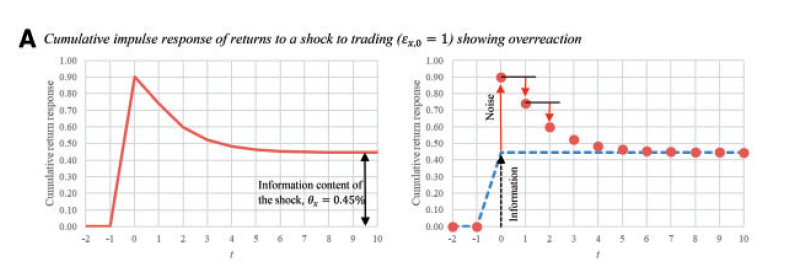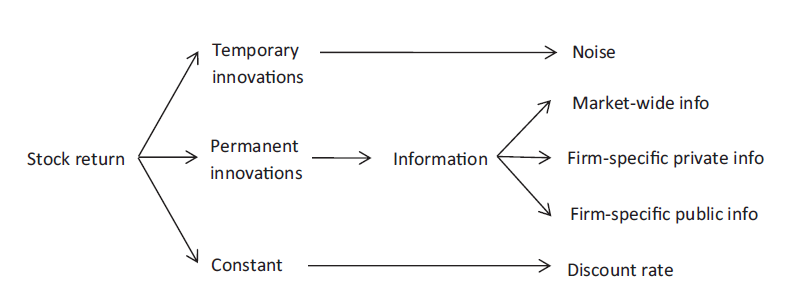Theory for the information-based decomposition of stock price
文章目录
- Motivation
- The potential of Brogaard Decomposition
- Intuitions for Brogaard decomposition
- Technique details in Brogaard decomposition
- Define the VAR system
- Identify the VAR system
- Variance decomposition
- Summary
- Main References
Motivation
Brogaard et al. (2022, RFS) proposed a new variance decomposition method (hereafter I call it Brogaard decomposition) for stock price volatility, which might be a powerful tool for both accounting and market micro-structure scholars to evaluate the impacts of informatinonal shocks on stock price informativeness. In this blog, I will introduce the potential and intuition of Brogaard decomposition, as well as the theory techniques embedded in this decomposition method.
The potential of Brogaard Decomposition
The method of Brogaard Decomposition provides a novel way to distinguish the roles of different types of information (e.g., market-wide information, firm-specific private information, firm-specific public information) and noise in stock price movements. This could be relevant for both accounting scholars, who focus on the micro firm-specific movements, and market micro-structure scholars, who have apparent interests in analyzing how do different informational arrangements in the market affect the price informativeness. Beyond that, one can aggregate the model outputs both in cross section and in time series, cultivating more macro insights on how does the overall market efficiency evolve over time.
Actually, Brogaard et al. (2022, RFS) has illustrated its potential through various tests. For example, by analyzing the time trend of the noise proportion in stock return variance, they show that market efficiency is dynamic, and is heavily influenced by the environment/market structure. Specifically, they find that the proportion of noise part in stock return movement is significantly responsive to a list of material changes in market microstructure like such as the exogenous decreases in tick size. Similarly, the proportion of firm-specific information part significantly increased after the implementation of Regulation Fair Disclosure (2000) and Sarbanes-Oxley Act (2022), both having increased the quality and quantity of corporate disclosure.
Moreover, as a powerful response to the recent concern that the prevalence of high-frequency trading and passive investment may dampen the degree of which firms’ prices reflect their idiosyncratic information (e.g., Baldauf and Mollner, 2020; Lee, 2020), Brogaard et al. (2022, RFS) show that the proportion of firm-specific information accounts in stock volatility didn’t see a significant decay in the last decade, when the concerning high-frequency trading as well as passive investment became prevalent.
Last but not least, as the price variance decomposition in Brogaard et al. (2022, RFS) is actually conducted in firm level, this method could also empower both the cross-sectional and time-series comparasion among different firms, which is particularly an important feature for accounting scholars. For example, Brogaard et al. (2022, RFS) show that while there is an on average increase in price changes attributed to firm-specific shocks since 2000s, such price improvement is mainly driven by large firms.

Intuitions for Brogaard decomposition
Following the spirit of Beveridge and Nelson (1991), Brogaard et al. (2022, RFS) perceive that an informational shock should cause the stock price to adjust both permanently and transiently. For example, a sudden burst of unexpected buying of a stock, which is perceived as a shock to firm-specific private information by Brogaard et al. (2022, RFS), typically causes the stock price to temporarily overreact and then subsequently revert to a new equilibrium level through time. Suppose it takes 10 period for the stock price to adjust to a new equilibrium price, then the difference between the 10-step-forward price and the price just before the informational shock arrives should be the permanent price adjustment attributed to the informational shock. Correspondingly, the difference between the temporary price and the new equilibrium price is the transient noise part. Brogaard et al. (2022, RFS) showed that such intuition also applies to price underreaction, arrivals of concurrent informational shocks, as well as dynamically arrived informational shocks.

Having established the idea to identify the impact of informational shocks on stock price adjustment, Brogaard et al. (2022, RFS) partitioned the information impounded into stock prices into three sources, and anything left over is called pricing error and is attributed to noises.
- market-wide information, with the corresponding innovation term εrm,t\varepsilon_{r_m, t}εrm,t- private firm-specific information incorporated through trading, with the corresponding innovation term εx,t\varepsilon_{x, t}εx,t- and public firm-specific information such as firm-specific news disseminated in company announcements and by the media, with the corresponding innovation term εr,t\varepsilon_{r, t}εr,t
By doing this, Brogaard et al. (2022, RFS) decompose the stock returns into four parts

where θrmεrm,t\theta_{r_m} \varepsilon_{r_m, t}θrmεrm,t captures the market-wide information incorporated into stock prices, θxεx,t\theta_x \varepsilon_{x, t}θxεx,t captures the firm-specific private information revealed through submitted orders, and θrεr,t\theta_r \varepsilon_{r, t}θrεr,t is the remaining part of firm-specific information that is not captured by trading on private information. Δst\Delta s_tΔst represents changes in the pricing errors.

Correspondingly, the variance of the realized stock returns σr2\sigma_r^2σr2 is composed of the following four parts:
MktInfo =θrm2σεrm2PrivateInfo =θx2σεx2PublicInfo =θr2σεr2Noise =σs2.\begin{aligned} \text { MktInfo } &=\theta_{r_m}^2 \sigma_{\varepsilon_{r_m}}^2 \\ \text { PrivateInfo } &=\theta_x^2 \sigma_{\varepsilon_x}^2 \\ \text { PublicInfo } &=\theta_r^2 \sigma_{\varepsilon_r}^2 \\ \text { Noise } &=\sigma_s^2 . \end{aligned}\notag MktInfoPrivateInfoPublicInfoNoise=θrm2σεrm2=θx2σεx2=θr2σεr2=σs2.Normalizing these variance components to sum to 100% gives variance shares:
MktInfoShare =θrm2σεrm2/(σw2+σr2)PrivateInfoShare =θx2σεx2/(σw2+σr2)PublicInfoShare =θr2σεr2/(σw2+σr2)NoiseShare =σs2/(σw2+σr2).\begin{aligned} \text { MktInfoShare } &=\theta_{r_m}^2 \sigma_{\varepsilon_{r_m}}^2 /(\sigma_w^2+\sigma_r^2 )\\ \text { PrivateInfoShare } &=\theta_{x}^2 \sigma_{\varepsilon_x}^2 /(\sigma_w^2+\sigma_r^2 ) \\ \text { PublicInfoShare } &=\theta_r^2 \sigma_{\varepsilon_r}^2 /(\sigma_w^2+\sigma_r^2 ) \\ \text { NoiseShare } &=\sigma_s^2 /(\sigma_w^2+\sigma_r^2 ) . \end{aligned} \notag MktInfoSharePrivateInfoSharePublicInfoShareNoiseShare=θrm2σεrm2/(σw2+σr2)=θx2σεx2/(σw2+σr2)=θr2σεr2/(σw2+σr2)=σs2/(σw2+σr2).where the variance of the realized stock returns σr2\sigma_r^2σr2 is the combination of the variance induced by informational shocks σw2\sigma_w^2σw2 and the variance attributed by noises σs2\sigma_s^2σs2.
σr2=σw2+σs2\sigma_r^2 = \sigma_w^2+\sigma_s^2 \notag σr2=σw2+σs2
Technique details in Brogaard decomposition
Define the VAR system
The system in Brogaard et al. (2022, RFS) is defined by a structural VAR with 3 variables and 5 lags
rm,t=∑l=15a1,lrm,t−l+∑l=15a2,lxt−l+∑l=15a3,lrt−l+εrm,tr_{m, t} =\sum_{l=1}^5 a_{1, l} r_{m, t-l}+\sum_{l=1}^5 a_{2, l} x_{t-l}+\sum_{l=1}^5 a_{3, l} r_{t-l}+\varepsilon_{r_m, t} rm,t=l=1∑5a1,lrm,t−l+l=1∑5a2,lxt−l+l=1∑5a3,lrt−l+εrm,t
xt=∑l=05b1,lrm,t−l+∑l=15b2,lxt−l+∑l=15b3,lrt−l+εx,tx_t =\sum_{l=0}^5 b_{1, l} r_{m, t-l}+\sum_{l=1}^5 b_{2, l} x_{t-l}+\sum_{l=1}^5 b_{3, l} r_{t-l}+\varepsilon_{x, t}xt=l=0∑5b1,lrm,t−l+l=1∑5b2,lxt−l+l=1∑5b3,lrt−l+εx,t
rt=∑l=05c1,lrm,t−l+∑l=05c2,lxt−l+∑l=15c3,lrt−l+εr,t(B1)r_t =\sum_{l=0}^5 c_{1, l} r_{m, t-l}+\sum_{l=0}^5 c_{2, l} x_{t-l}+\sum_{l=1}^5 c_{3, l} r_{t-l}+\varepsilon_{r, t}\tag{B1}rt=l=0∑5c1,lrm,t−l+l=0∑5c2,lxt−l+l=1∑5c3,lrt−l+εr,t(B1)
where
- rm,tr_{m,t}rm,t is the market return, the corresponding innovation εrm,t\varepsilon_{r_{m,t}}εrm,t represents innovations in market-wide information
- xtx_txt is the signed dollar volume of trading in the given stock, the corresponding innovation εx,t\varepsilon_{x,t}εx,t represents innovations in firm-specific private information
- rtr_trt is the stock return, the corresponding innovation εr,t\varepsilon_{r,t}εr,t represents innovations in firm-specific public information
- the authors assume that εrm,t,εx,t,εr,t\\{\varepsilon_{r_m, t}, \varepsilon_{x, t}, \varepsilon_{r, t}\\}εrm,t,εx,t,εr,t are contemporaneously uncorrelated
Identify the VAR system
- first estimate the reduced-form version of the VAR model
rm,t=a0∗+∑l=15a1,l∗rm,t−l+∑l=15a2,l∗xt−l+∑l=15a3,l∗rt−l+erm,txt=b0∗+∑l=15b1,l∗rm,t−l+∑l=15b2,l∗xt−l+∑l=15b3,l∗rt−l+ex,trt=c0∗+∑l=15c1,l∗rm,t−l+∑l=15c2,l∗xt−l+∑l=15c3,l∗rt−l+er,t(B2)\begin{aligned} &r_{m, t}=a_0^*+\sum_{l=1}^5 a_{1, l}^* r_{m, t-l}+\sum_{l=1}^5 a_{2, l}^* x_{t-l}+\sum_{l=1}^5 a_{3, l}^* r_{t-l}+e_{r_m, t} \\ &x_t=b_0^*+\sum_{l=1}^5 b_{1, l}^* r_{m, t-l}+\sum_{l=1}^5 b_{2, l}^* x_{t-l}+\sum_{l=1}^5 b_{3, l}^* r_{t-l}+e_{x, t} \\ &r_t=c_0^*+\sum_{l=1}^5 c_{1, l}^* r_{m, t-l}+\sum_{l=1}^5 c_{2, l}^* x_{t-l}+\sum_{l=1}^5 c_{3, l}^* r_{t-l}+e_{r, t} \end{aligned} \tag{B2} rm,t=a0∗+l=1∑5a1,l∗rm,t−l+l=1∑5a2,l∗xt−l+l=1∑5a3,l∗rt−l+erm,txt=b0∗+l=1∑5b1,l∗rm,t−l+l=1∑5b2,l∗xt−l+l=1∑5b3,l∗rt−l+ex,trt=c0∗+l=1∑5c1,l∗rm,t−l+l=1∑5c2,l∗xt−l+l=1∑5c3,l∗rt−l+er,t(B2)
impose Cholesky decomposition, forcing all elements above the principal diagonal of B−1B^{-1}B−1 to be 0 so that the system can be exactly identified
[erm,tex,ter,t]=[100b1,010b2,0b2,11][εrm,tεx,tεr,t](B3)\left[\begin{array}{l} e_{r_m, t} \\ e_{x, t} \\ e_{r, t} \end{array}\right]=\left[\begin{array}{lll} 1 & 0 & 0 \\ b_{1,0} & 1 & 0 \\ b_{2,0} & b_{2,1} & 1 \end{array}\right]\left[\begin{array}{l} \varepsilon_{r_m, t} \\ \varepsilon_{x, t} \\ \varepsilon_{r, t} \end{array}\right]\tag{B3}
erm,tex,ter,t=1b1,0b2,001b2,1001εrm,tεx,tεr,t(B3) these imposed restrictions imply
- the market return rmr_mrm is not contemporaneously affected by innovations in individual returns εr,t\varepsilon_{r,t}εr,t or individual order imbalance/trading volume εx,t\varepsilon_{x,t}εx,t - the individual order imbalance/trading volume is not contemporaneously affected by innovations in individual stock return εr,t\varepsilon_{r,t}εr,t
the equation (B3) implies
erm,t=εrm,tex,t=εx,t+b1,0εrm,t=εx,t+b1,0erm,t(B4)\begin{gathered} e_{r_m, t}=\varepsilon_{r_m, t} \\ e_{x, t}=\varepsilon_{x, t}+b_{1,0} \varepsilon_{r_m, t}=\varepsilon_{x, t}+b_{1,0} e_{r_m, t} \end{gathered}\tag{B4} erm,t=εrm,tex,t=εx,t+b1,0εrm,t=εx,t+b1,0erm,t(B4)
for ease of estimation, to write er,te_{r,t}er,t as the function of erm,te_{r_m,t}erm,t and ex,te_{x,t}ex,t
er,t=c1,0erm,t+c2,0ex,t+εr,t(B5)e_{r,t}=c_{1,0} e_{r_m, t}+c_{2,0} e_{x, t}+\varepsilon_{r, t} \tag{B5} er,t=c1,0erm,t+c2,0ex,t+εr,t(B5)plug (B4) into (B5) and get
er,t=εr,t+(c1,0+c2,0b1,0)εrm,t+c2,0εx,t(B6)e_{r,t}=\varepsilon_{r, t}+\left(c_{1,0}+c_{2,0} b_{1,0}\right) \varepsilon_{r_m, t}+c_{2,0} \varepsilon_{x, t} \tag{B6} er,t=εr,t+(c1,0+c2,0b1,0)εrm,t+c2,0εx,t(B6)
thus
- regress ex,te_{x,t}ex,t on erm,te_{r_m,t}erm,t, one can get b1,0b_{1,0}b1,0
- regress er,te_{r,t}er,t on erm,te_{r_m,t}erm,t, one can get c1,0c_{1,0}c1,0
- regress er,te_{r,t}er,t on ex,te_{x,t}ex,t, one can get c2,0c_{2,0}c2,0
- note that ex,te_{x,t}ex,t, er,te_{r,t}er,t, er,te_{r,t}er,t are residuls estimated from the reduced-form VAR system (B2)
with the estimated parameters b1,0,c1,0,c2,0b_{1,0}, c_{1,0},c_{2,0}b1,0,c1,0,c2,0 and the estimated variances of the reduced-form residuals (σerm2,σex2,and σer2)\left(\sigma_{e_{r_m}}^2, \sigma_{e_x}^2, \text { and } \sigma_{e_r}^2\right)(σerm2,σex2,andσer2), one can obtain the variances of the innovation terms based on equation (B4) and (B6)
σεrm2=σerm2σεx2=σex2−b1,02σerm2σεr2=σer2−(c1,02+2c1,0c2,0b1,0)σerm2−c2,02σex2.(B7)\begin{aligned}\sigma_{\varepsilon_{r_m}}^2 &=\sigma_{e_{r_m}}^2 \\ \sigma_{\varepsilon_x}^2 &=\sigma_{e_x}^2-b_{1,0}^2 \sigma_{e_{r_m}}^2 \\ \sigma_{\varepsilon_r}^2 &=\sigma_{e_r}^2-\left(c_{1,0}^2+2 c_{1,0} c_{2,0} b_{1,0}\right) \sigma_{e_{r_m}}^2-c_{2,0}^2 \sigma_{e_x}^2 .\end{aligned} \tag{B7} σεrm2σεx2σεr2=σerm2=σex2−b1,02σerm2=σer2−(c1,02+2c1,0c2,0b1,0)σerm2−c2,02σex2.(B7)
whereσεr2=σer2−(c1,0+c2,0b1,0)2σerm2−c2,02(σex2−b1,02σerm2)\sigma_{\varepsilon_r}^2=\sigma_{e_r}^2-\left(c_{1,0}+c_{2,0} b_{1,0}\right)^2\sigma_{e_{r_m}}^2-c_{2,0}^2(\sigma_{e_x}^2-b_{1,0}^2 \sigma_{e_{r_m}}^2) σεr2=σer2−(c1,0+c2,0b1,0)2σerm2−c2,02(σex2−b1,02σerm2)
the impulse response can be generically conducted with the exactly identified VAR system
Variance decomposition
the cumulative return response to each of the innovations εrm,t,εx,t,εr,t\varepsilon_{r_m, t}, \varepsilon_{x, t}, \varepsilon_{r, t}εrm,t,εx,t,εr,t at ttt =15 (point at which the authors believe the responses are generally stable) gives estimates of θrm,θx,θr\theta_{r_m}, \theta_x, \theta_rθrm,θx,θr respectively
in particular, the 15-step-ahead forecast error for stock return is
rt+15−Etrt+15=ϕ31(0)εrmt+15+ϕ31(1)εrmt+15−1+⋯+ϕ31(14)εrmt+1+ϕ32(0)εxt+15+ϕ32(1)εxt+15−1+⋯+ϕ32(14)εxt+1+ϕ33(0)εrt+15+ϕ33(1)εrt+15−1+⋯+ϕ33(14)εrt+1\begin{aligned}r_{t+15}- E_t r_{t+15}&=\phi_{31}(0) \varepsilon_{r_m t+15}+\phi_{31}(1) \varepsilon_{r_m t+15-1}+\cdots+\phi_{31}(14) \varepsilon_{r_m t+1} \\ &+\phi_{32}(0) \varepsilon_{xt+15}+\phi_{32}(1) \varepsilon_{xt+15-1}+\cdots+\phi_{32}(14) \varepsilon_{xt+1} \\ &+\phi_{33}(0) \varepsilon_{rt+15}+\phi_{33}(1) \varepsilon_{rt+15-1}+\cdots+\phi_{33}(14) \varepsilon_{rt+1} \end{aligned} rt+15−Etrt+15=ϕ31(0)εrmt+15+ϕ31(1)εrmt+15−1+⋯+ϕ31(14)εrmt+1+ϕ32(0)εxt+15+ϕ32(1)εxt+15−1+⋯+ϕ32(14)εxt+1+ϕ33(0)εrt+15+ϕ33(1)εrt+15−1+⋯+ϕ33(14)εrt+1
the 15-step-ahead forecast error variance of rt+15r_{t+15}rt+15 should contain
θrmσεrm2+θxσεx2+θrσεr2=σεrm2[ϕ31(0)2+ϕ31(1)2+⋯+ϕ31(14)2]+σεx2[ϕ32(0)2+ϕ32(1)2+⋯+ϕ32(14)2]+σεr2[ϕ31(0)2+ϕ31(1)2+⋯+ϕ31(14)2]\begin{aligned}\theta_{r_m}\sigma_{\varepsilon_{r_m}}^2+\theta_{x}\sigma_{\varepsilon_{x}}^2+\theta_{r}\sigma_{\varepsilon_{r}}^2&=\sigma_{\varepsilon_{r_m}}^2\left[\phi_{31}(0)^2+\phi_{31}(1)^2+\cdots+\phi_{31}(14)^2\right]\\ &+\sigma_{\varepsilon_x}^2\left[\phi_{32}(0)^2+\phi_{32}(1)^2+\cdots+\phi_{32}(14)^2\right]\\ &+\sigma_{\varepsilon_r}^2\left[\phi_{31}(0)^2+\phi_{31}(1)^2+\cdots+\phi_{31}(14)^2\right]\end{aligned} θrmσεrm2+θxσεx2+θrσεr2=σεrm2[ϕ31(0)2+ϕ31(1)2+⋯+ϕ31(14)2]+σεx2[ϕ32(0)2+ϕ32(1)2+⋯+ϕ32(14)2]+σεr2[ϕ31(0)2+ϕ31(1)2+⋯+ϕ31(14)2]
- anything left in σr2(15)\sigma_r^2 (15)σr2(15) is attributed to noises
Summary
In this blog, I firstly discussed the potential of the variance decomposition method developed by Brogaard et al. (2022, RFS). Then I illustrate the intuition as well as the theoretical techniques employed by the Brogaard decomposition.
Main References
- Baldauf, Markus, and Joshua Mollner. “High‐frequency trading and market performance.” The Journal of Finance 75.3 (2020): 1495-1526.
- Bernanke, Ben S. “Alternative explanations of the money-income correlation.” (1986).
- Beveridge, Stephen, and Charles R. Nelson. “A new approach to decomposition of economic time series into permanent and transitory components with particular attention to measurement of the ‘business cycle’.” Journal of Monetary Economics 7, no. 2 (1981): 151-174.
- Blanchard, Olivier J., and Danny Quah. “The Dynamic Effects of Aggregate Demand and Supply Disturbances.” The American Economic Review 79, no. 4 (1989): 655-673.
- Enders, Walter. “Applied Econometric Time Series. 2th ed.” New York (US): University of Alabama (2004).
- Lee, Jeongmin. “Passive investing and price efficiency.” Available at SSRN 3725248 (2020).
- Sims, Christopher A. “Macroeconomics and reality.” Econometrica (1980): 1-48.
Theory for the information-based decomposition of stock price相关推荐
- Computer Science Theory for the Information Age-3: 高维空间中的高斯分布和随机投影
Computer Science Theory for the Information Age-3: 高维空间中的高斯分布和随机投影 高维空间中的高斯分布和随机投影 (一)在高维球体表面产生均匀分布点 ...
- Computer Science Theory for the Information Age-4: 一些机器学习算法的简介
Computer Science Theory for the Information Age-4: 一些机器学习算法的简介 一些机器学习算法的简介 本节开始,介绍<Computer Scien ...
- Computer Science Theory for the Information Age-1: 高维空间中的球体
Computer Science Theory for the Information Age-1: 高维空间中的球体 高维空间中的球体 注:此系列随笔是我在阅读图灵奖获得者John Hopcroft ...
- Replicate Brogaard Stock Volatility Decomposition
文章目录 Introduction Data and Sample Download Data Clean Data Extract Estimation Unit and Set Global Va ...
- 快排递归非递归python_Python递归神经网络终极指南
快排递归非递归python Recurrent neural networks are deep learning models that are typically used to solve ti ...
- power bi可视化表_滚动器可视化功能,用于Power BI Desktop中的股价变动
power bi可视化表 In the article, Candlestick chart for stock data analysis in Power BI Desktop, we explo ...
- The Cross-section of Expected Stock Return 1992翻译(续)
I. Preliminaries Ⅰ.准备工作 A. Data 数据 We use all nonfinancial firms in the intersection of (a) the NYSE ...
- THE WAVELET THEORY: A MATHEMATICAL APPROACH
文章目录 Basis Vectors Inner Products, Orthogonality, and Orthonormality EXAMPLES THE WAVELET SYNTHESIS ...
- 计算机视觉论文-2021-06-04
本专栏是计算机视觉方向论文收集积累,时间:2021年6月4日,来源:paper digest 欢迎关注原创公众号 [计算机视觉联盟],回复 [西瓜书手推笔记] 可获取我的机器学习纯手推笔记! 直达笔记 ...
最新文章
- php 正则中文匹配
- LeetCode 319. Bulb Switcher--C++,java,python 1行解法--数学题
- RHEL5+ImageMagick-6.4.0-0+jmagick-6.4.0+resin 解决方案
- LeetCode Single Number II(位操作)
- Winform中实现双击Dev的TreeList在ZedGraph中生成对应颜色的曲线
- 阔步向前冲,拥抱云计算-【软件和信息服务】2012.10
- iphone降级 无需电脑_88 元淘来的 iPhone 4 降级到 iOS 6,甚至还能跑 “大型游戏”...
- android+3.0新加的动画,Android动画片
- Java Web学习总结(5)——HttpServletResponse对象详解
- 安:[摩斯密码表]摩斯密码对照表
- usb调试助手_【小白教程】如何使用米卓同屏助手?
- ubuntu 自动登录账户_Ubuntu如何启用root默认自动登录
- 经济学中的同比环比,负增长,正增长
- 计算机安全常用防护策略,新手必看
- 工作了17年,2021年双11是我见过有史以来“撸腾讯云羊毛”最狠的一次,血赚
- data: function () { return {}} ——你不应该在一个子组件内部改变 prop
- 一招秒杀常见网页基本排版布局
- 车辆违章查询接口文档
- 计算机有没有32进制,32进制(32进制转换十进制)
- 沪股通、深股通、港股通、陆股通
